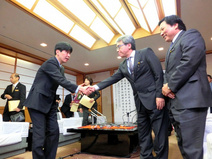 Source: asahi.com
Source: asahi.com On Friday Minister Yamamoto presented the government’s plan to Okinawa Prefecture Governor Nakaima, before following this up with a meeting with members of the Henoko City Council on Saturday to (in a long worn out phrase) gain the “understanding” of council members in relation to what the government was planning (J). Given the fact that the government has proposed an exchange in territory in order to reduce the burden on Ginowan City imposed by the Futenma base, while simultaneously offering the US an alternative venue to continue the US Marine presence in Okinawa, one would think that this might garner the support of the prefectural government. Yet it hasn’t.
In response to the proposal (which is expected to be subject to 8 to 10 months of analysis before any verdict is reached), Governor Nakaima again reiterated Okinawa’s preference for any new base to be located outside of Okinawa (J). In return, Defence Minister Onodera expressed the government’s preference for a decision on construction to be made before the Nago City (in which Henoko is located) mayoral election goes ahead in January next year (J).
So what does all this mean? Firstly, it means that the Abe government is not going to deviate from its predecessors in wanting to re-organise the base distribution system in Okinawa. This issue has been tossed around by successive governments since the late 1990s, and given the fact that Okinawa is now located smack bang in the middle of a potentially volatile strategic region means that neither the Japanese nor the US governments are going to change their minds about placing a new base in Okinawa. The Okinawan prefectural government is well aware of this, as for years it has been calling on both Tokyo and Washington to find an alternative venue only for each successive administration to back the construction of a new base in Okinawa.
Secondly, if the Okinawan prefectural government does not approve the relocation of the base to Henoko, there is every chance that Tokyo will simply force the construction to go ahead regardless. When the future of the alliance with the US depends on cooperation on security issues, the Abe government is not likely to yield to the wishes of Okinawans given the threats present in the region and the need to have a joint US-Japan military presence to offset any moves by China or North Korea to upset the status quo.
This blog has previously voiced concern at what might happen should Tokyo ignore local voices that oppose the moving of Futenma base to Henoko, and whether this might lead in turn to civil unrest and the possibility of urban terrorism directed against both central government institutions and the US Marines themselves. The fact that the Marines have had a presence in Okinawa for the past 68 years with relatively little animosity directed at them by Okinawans themselves does not guarantee that animosity won’t turn into outright violent hostility, a hostility that could be exploited by states such as China.
Consider for a moment the possibility of Chinese intelligence officers infiltrating local Okinawan residential groups, linking up with members radicalised by Tokyo’s indifference to local concerns. They could then provide such groups with explosives and arms training and tell them to target US and SDF defence facilities and personnel, including SDF patriot missile batteries and early warning radar systems.
Clearly this situation would not be in either Tokyo’s, Washington’s, nor Naha’s interests, as any civilian terrorist groups would inflict collateral damage against their fellow Okinawans, ruin the Okinawan tourism trade, sew hostility in the Marines against the local population (leading to further incidents), and undermine Okinawa’s key place in regional security networks. Since the issue of Okinawan bases has occupied policy minds for over 20 years, and that a shift has occurred in the strategic environment of Northeast Asia, it seems that the only chance of a breakthrough will be for one side to declare that it will accept the needs of the other and try to accommodate those needs as best it can.
As neither Tokyo nor Washington can afford the expense involved in shifting the entire Futenma base to Guam nor another part of Japan (which is an entirely different post in itself), it does seem that the key to a resolution lies in Okinawa and its prefectural government. If Tokyo is prepared to absorb the entire cost of base relocation (which it is), provide employment to Okinawans involved in construction, transport, logistics, hospitality, and more beside, work with the US to ensure local Okinawans have opportunities for continuing employment (such as the redevelopment of the Futenma base area), while the US has agreed to relocate parts of the Marines to other bases in the Pacific, really the onus does come down on the Okinawan prefectural government to accept the need for cooperation with Tokyo and promote this view to Okinawans.
Whether this can occur under Governor Nakaima is debatable, considering he has nailed himself to the cause of closing down Futenma base (and ensuring that no subsequent bases are built within Okinawa). As Governor Nakaima was re-elected in November 2010, and given that no subsequent elections will be held until November 2014, that might stall any possibility of progressive negotiations, especially since analysis of the government’s proposal will not finish until January 2014. Even if Governor Nakaima does not choose to run again, his successor will most certainly pursue the same course, as may other parties in Okinawa. And so the debate will continue ad infinitum when what is needed is compromise.



 RSS Feed
RSS Feed